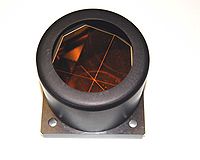
Photo from wikipedia
The thermal stress due to the thermal expansion mismatch could induce crystallographic defects such as buckling and cracking and degrade device performance. In this paper, the thermal stress distribution in… Click to show full abstract
The thermal stress due to the thermal expansion mismatch could induce crystallographic defects such as buckling and cracking and degrade device performance. In this paper, the thermal stress distribution in a laser array structure selectively grown on V-groove-patterned Si substrates was investigated by two-dimension finite-element method. Surprisingly, unexpected results are observed that the top of the InGaAs active layer and the most region of the InP cap layer are in compression, which is far different from the thermal stress distribution in planar structures. Two mechanisms have been proposed and modeled to explain the difference—(i) the width of uncoalesced layers is smaller than that of the Si substrate, which causes thermal stress to change in epitaxial layers, and (ii) thermal stress in the InGaAs and InP layers is affected by the V-groove structure. The results show that whether or not the epitaxial layers are coalesced has significant effect on the thermal stress distribution. The effect of the height of the V-groove, the height and the width of the SiO2 mask on the thermal stress distribution was also studied. It is found that the height of V-groove and the height of SiO2 mask play a critical role in the stress distribution. These findings are useful for the optimal designs for the laser array and provide an important step towards the realization of photonic integration circuits on silicon.The thermal stress due to the thermal expansion mismatch could induce crystallographic defects such as buckling and cracking and degrade device performance. In this paper, the thermal stress distribution in a laser array structure selectively grown on V-groove-patterned Si substrates was investigated by two-dimension finite-element method. Surprisingly, unexpected results are observed that the top of the InGaAs active layer and the most region of the InP cap layer are in compression, which is far different from the thermal stress distribution in planar structures. Two mechanisms have been proposed and modeled to explain the difference—(i) the width of uncoalesced layers is smaller than that of the Si substrate, which causes thermal stress to change in epitaxial layers, and (ii) thermal stress in the InGaAs and InP layers is affected by the V-groove structure. The results show that whether or not the epitaxial layers are coalesced has significant effect on the thermal stress distribution. The effect of the...
Journal Title: AIP Advances
Year Published: 2018
Link to full text (if available)
Share on Social Media: Sign Up to like & get
recommendations!